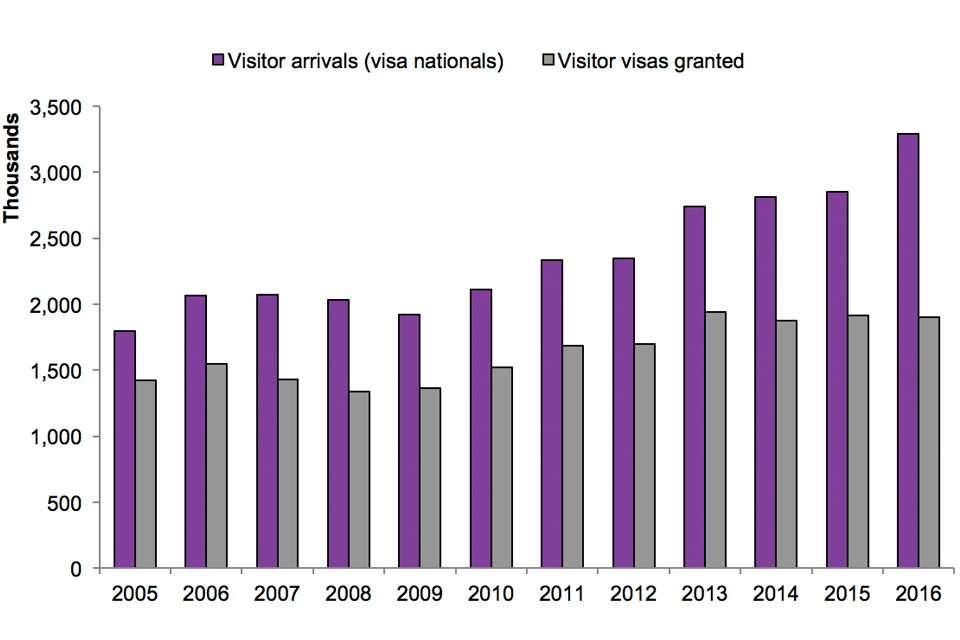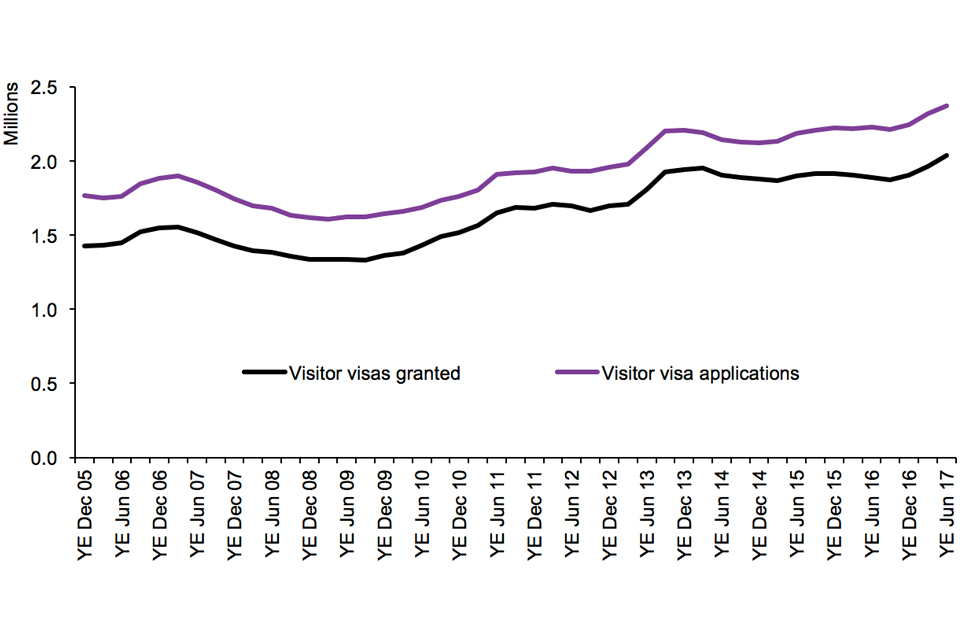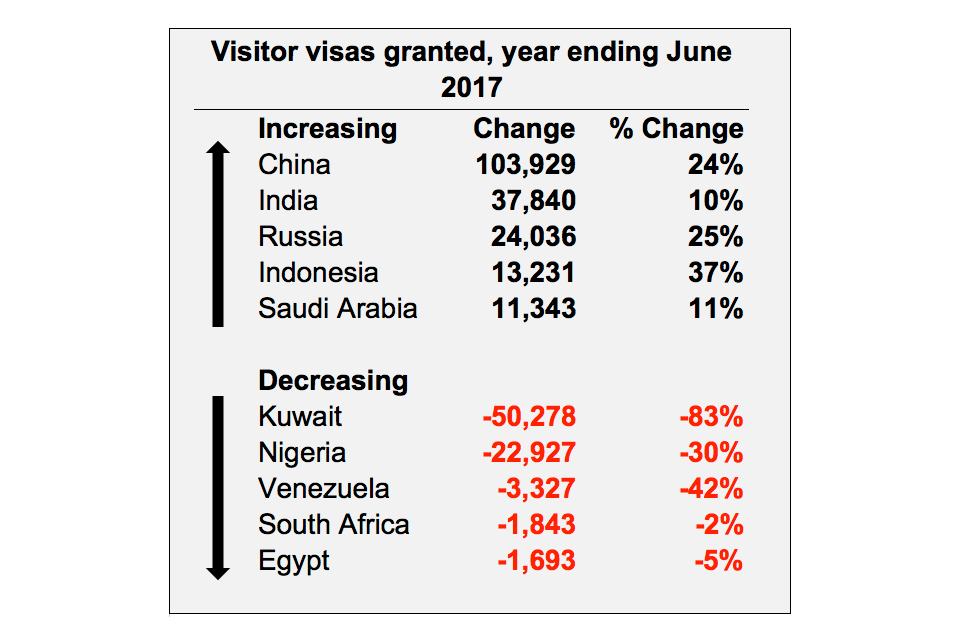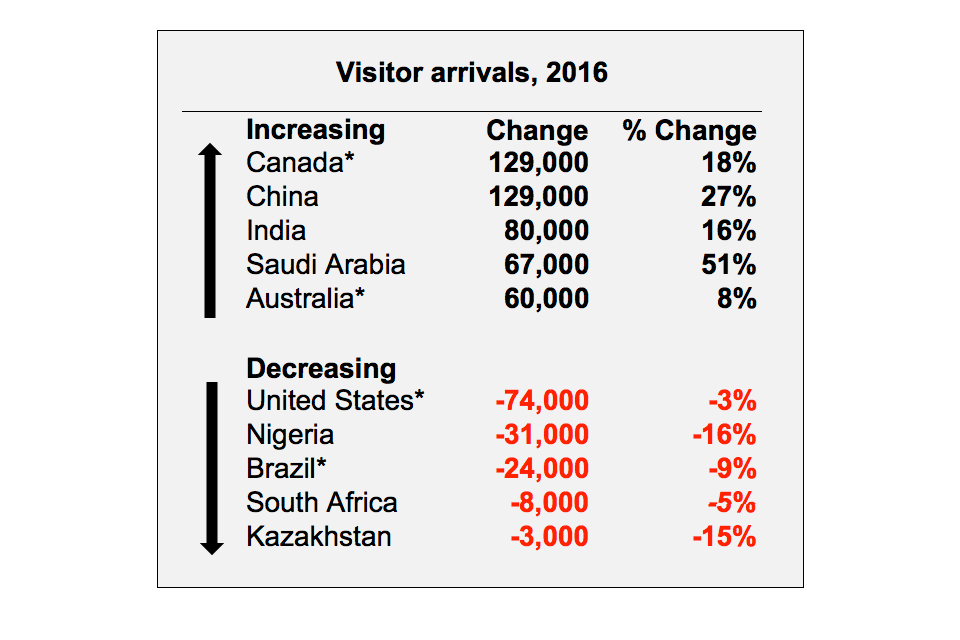Why do people come to the UK? (1) To visit
Published 24 August 2017
Immigration statistics April to June 2017 content page.
This is not the latest release. View latest release.
This section includes information on visitors to the UK. Visitor arrivals data for non-European Economic Area (EEA) nationals are based on landing cards completed as people cross the border. Visitor visa data relate to grants of visas applied for outside the UK. More information on non-visitor arrival and visa data by reason and nationality is included in Why do people come to the UK? (2) To work, Why do people come to the UK? (3) To study and Why do people come to the UK? (4) For family reasons.
Visitor arrivals are much higher than the number of visitor visas granted as ‘non-visa nationals’ (for example nationals of the US, Brazil and Japan) do not need a visa to come to the UK for a visit of less than 6 months. Visa nationals must obtain a visa before travelling to the UK (except in certain circumstances), unless they are returning residents or those with permission to stay who are returning after a temporary absence. A non-visa national does not normally need a visa to visit the UK for less than 6 months, unless it is a requirement of the immigration category under which they are entering, such as to ‘work’ in the UK. Any non-visa national coming to the UK for more than 6 months will need a visa.
Omani, Qatari and United Arab Emirates (UAE) nationals were able to visit the UK without a visa from 1 January 2014 as part of the Electronic Visa Waiver (EVW) scheme, which resulted in significant falls for these nationalities. This scheme was extended to Kuwaiti nationals from 21 February 2016. Those arriving with an EVW are included in the visa national visitor arrivals but are excluded from Visitor visas granted as they would not have been granted a visa to travel as a visitor.
1. Key facts
In 2016, the number of non-EEA visitor arrivals increased by 0.7 million (7%) to 10.1 million. Over a quarter (26%) of all non-EEA visitor arrivals were United States (US) nationals. International Passenger Survey estimates, published by the ONS show a 7% increase in the number of visits to the UK by overseas (non-UK) residents to 3.5 million in June 2017, compared with June 2016.
A number of nationalities, including US nationals, do not normally require a visa to visit the UK. Consequently the number of Visitor visas granted is much lower than the total number of arrivals. Over 2.6 million visas were granted in the year ending June 2017 and, of these, over 2 million (77%) were to visit.
There were 150,225 (8%) more Visitor visas granted in the year ending June 2017. There were notable increases in Visitor visas granted to Chinese nationals, up by 103,929 (24%) to 536,125 (excluding Hong Kong), and Indian nationals, up 37,840 (10%) to 414,331, and together these two nationalities accounted for 47% of all visit visas granted.
2. Visitors (non-EEA)
In 2016, there were 10.1 million visitor arrivals, of which 87% (8.8 million) were ‘ordinary’ visitors and 13% (1.4 million) were arrivals by business visitors. Passengers are counted each time they enter the UK. Where an individual enters more than once in a period they will be counted each time they enter. The numbers of visitors admitted to the UK remained stable from 2004 to 2012, after which the number of visitors increased by 32% from 7.7 million in 2012 to 10.1 million in 2016.
For those visitors who are required to obtain a visa in advance of travelling, in year ending June 2017 there were 2.4 million visitor visa applications (about 150,000 more than the previous period) and 2 million were granted (up 8%).
The volume of visitor arrivals for visa nationals is higher than Visitor visas granted, likely owing to the fact that visitors could ‘arrive’ in the UK on multiple occasions over the period that their visa is valid for. Non-visa national visitor arrivals are much higher in volume but have also followed a similar trend since 2005 with increases since calendar years 2008 and 2009. The chart below shows the trend in visitor arrivals and Visitor visas granted for visa nationalities only. The ratio of visitor arrivals to Visitor visas granted has increased steadily over time.
Long-term trends in visitor arrivals and visitor visas granted (visa nationals only)

Chart notes
Source: Home Office, Immigration Statistics April to June 2017, Visas table vi 06 q (Visas volume 3) and Admissions table ad 03 o.
Statistics on visitor visas granted in 2016 can be found in Visas table vi 01 q. The number of visitor arrivals for 2017, by nationality, is due to be published in August 2018.
Entry clearance visa applications and resolution: Visitors
There were increases in visitor visa applications, resolved and granted in the year ending June 2017. Grant and refusal rates have remained fairly similar over the last few years.
| Year ending | Applications | Resolved | Granted | % | Refused | % | Withdrawn or lapsed |
|---|---|---|---|---|---|---|---|
| Year ending June 2013 | 2,090,741 | 2,078,641 | 1,808,782 | 87% | 260,310 | 13% | 9,549 |
| Year ending June 2014 | 2,142,125 | 2,166,031 | 1,906,861 | 88% | 251,447 | 12% | 7,723 |
| Year ending June 2015 | 2,186,202 | 2,188,606 | 1,900,834 | 87% | 279,460 | 13% | 8,312 |
| Year ending June 2016 | 2,227,182 | 2,214,449 | 1,887,373 | 85% | 322,089 | 15% | 4,987 |
| Year ending June 2017 | 2,374,770 | 2,347,206 | 2,037,598 | 87% | 304,625 | 13% | 4,983 |
| Change: latest 12 months | +147,588 | +132,757 | +150,225 | -17,464 | -4 | ||
| Percentage change | +7% | +6% | +8% | -5% | 0% |
Table notes
Source: Home Office, Immigration Statistics April to June 2017, Visas table vi 01 q (Visas volume 1).
Long-term trends in visitor visa applications and grants

Chart notes
Source: Home Office, Immigration Statistics April to June 2017. Statistics on visitor visas applications and visitor visas granted in the year ending June 2017 can be found in Visas table vi 01 q (Visas volume 1).
3. Duration of Visitor visas
Visitor visas are usually issued for up to a maximum of 6 months (or in some cases, up to a maximum of 12 months). Visitor visas with a longer duration of validity (of 2, 5 or 10 years) can be issued to those who need to visit the UK regularly over a longer period and allow stays of up to a maximum of 6 months on each visit.
Of the 2 million Visitor visas granted in year ending June 2017, 68% (1.4 million) were for up to 6 months and 32% (0.6 million) were longer-term visit visas.
4. Trends in visitor visas and arrivals by nationality
There were 2,037,598 Visitor visas granted in year ending June 2017, an increase of 150,225 (8%) compared with year ending June 2016. Excluding Kuwaiti nationals, who were able to visit the UK without a visa from 21 February 2016 as part of the EVW scheme, the number of visitor visas granted was 1,826,689 in year ending June 2016 and 2,027,192 in year ending June 2017.
There were notable increases in Visitor visa grants for Chinese nationals, up by 103,929 (24%) to 536,125 (excluding Hong Kong), and Indian nationals, up 37,840 (10%) to 414,331. Together these two nationalities account for 46% of visit visas granted. By contrast there were large falls in numbers of Visitor visas granted to Kuwaiti nationals (down 50,278 to 10,406) following the introduction of the EVW scheme in February 2016, and Nigerian nationals down 22,927 (30%) to 53,175. The diagram below illustrates the latest trends in Visitor visas granted.

Table notes
Source: Home Office, Immigration statistics April to June 2017, Visas table vi 06 q o (Visas volume 3).
Omani, Qatari and UAE nationals were able to visit the UK without a visa from 1 January 2014 (the EVW scheme was introduced on 1 January 2014 resulting in significant falls for these nationalities). This scheme was extended to Kuwaiti nationals from 21 February 2016.
There were 10.1 million visitor arrivals in 2016, an increase of 0.7 million (7%) compared with 2015.
Arrivals from US nationals, the largest nationality for visitors to the UK, decreased by 74,000 (3%) and arrivals from Brazilian nationals decreased by 24,000 (9%). Nationals from these countries do not need a visa to visit the UK for up to 6 months. The diagram below illustrates the latest trends in visitor arrivals.

Table notes
Source: Home Office, Immigration Statistics April to June 2017, Admissions table ad 03 o.
Omani, Qatari and UAE nationals were able to visit the UK without a visa from 1 January 2014 (the EVW scheme was introduced on 1 January 2014 resulting in significant falls for these nationalities). This scheme was extended to Kuwaiti nationals from 21 February 2016.
* Non-visa national country. Nationals from these countries do not need a visa to visit the UK for stays of up to 6 months.
5. Data tables
Data on passenger arrivals and visa, sourced from Home Office administrative systems, can be found in:
Visas tables volume 1
Visas tables volume 2
Visas tables volume 3
Admissions tables
